Once Mario automatically descends the pipe beyond the first fortress, World 1-2 begins in earnest. It brings about a significant change in setting: Mario goes underground, leaving behind the blue skies and calliope music of World 1-1 in favor of gloom. In fact, the blue-tinted Goombas who live down here have retroactively been renamed “Gloombas,” because Nintendo just can’t leave well enough alone when there’s the possibility of a pun happening.
But the simple change in color palettes — blue sky becoming black shadow, warm brown brick becoming cool blue-grey — and the shift in music to something more muted and repetitive does the trick. It also calls to mind the tricks the same developers would use a few months later to distinguish The Legend of Zelda‘s dungeons from its overworld. (A connection that would be played with a few times over the years, particularly in Link’s Awakening and Super Mario 3D Land).
World 1-2 adds a couple of new elements to the Mario sandbox, and it also gives players a chance to experiment with some advanced techniques, should it strike their fancy (or even occur to them to try).
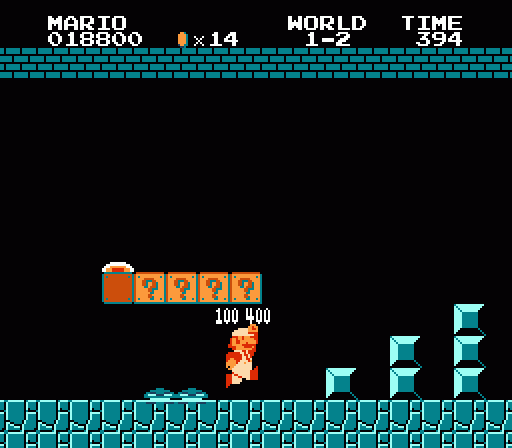
The stage begins simply enough: Mario drops from the pipe above into a cavern, or possibly a sewer of some sort (another of the game’s very vague, very vestigial connections to Mario Bros.). Right away you’ll see a row of Question Blocks — the only objects in this stage not to undergo a darker palette shift, besides Mario — the first of which contains a power-up. Two Gloombas walk side-by-side beneath the blocks.
It seems a simple enough situation, but it’s subtly complex — another one of those situations that requires a quick, instinctive response and a proper understanding of the game’s inner workings. If you’ve carried over a Fire Flower from World 1-1, this is easy enough to deal with: You pepper the Gloombas with fire, end of story. But if you skipped the Fire Flower, this situation can be more dangerous than a newcomer to the game would expect. The low placement of the blocks above the Gloombas will cause Super (or Fiery) Mario to bump his head when he attempts to vault the enemies, cutting his jump short and sending him quickly downward. Super Mario has only a few pixels’ clearance over the Goombas, requiring a very precise jump.
It can be tricky to get the jump just right, but this situation is also much less stressful if you’re forced to restart the level without a power-up. Standard Mario, being shorter, can jump higher before bumping the blocks, making it much easier to stomp the enemies in his weakened state. There are a couple of situations in this stage in which small Mario has a small advantage over Super Mario.
Of course, you don’t have to jump them beneath the blocks. You can also wait for them to emerge from beneath the row of Question Blocks and jump them at your leisure, or you can skip them altogether by hopping on the blocks and running past — though this does run the risk of scrolling the power-up block off-screen. And clearly the level designers meant for you to try and squash them right away, as the Gloombas walk directly together rather than a small space apart: If you squash the first one as Super Mario, your rebound bounce will cause you to immediately hit the blocks above and drop sharply onto the second. Elsewhere in the game, you’ll usually see Goombas walking slightly apart so that Mario’s reflex will create natural attack combos. But here, in this constrained space, such a gap would cause you to drop too soon from the first jump and cause the second Gloomba to bump into you on the ground.
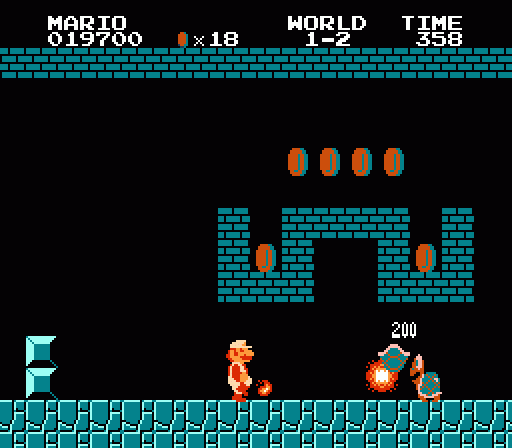
Beyond here you’ll find a series of one-block-wide columns separated by small gaps. Traversing such narrow obstacles requires considerable finesse, and it’s a skill you’ll need later. Here, you have a chance to practice with it in a fairly safe setting; aside from a single Gloomba patrolling between two of the columns, this is a harmless set of obstacles that allows you to come to terms with the fine precision of Mario’s jumps.
And if you fall and have to deal with the Gloomba, there’s even a reward: A brick that turns out to contain a multi-coin block. Because it’s set slightly higher, you can only squeeze 10 coins out of it rather than the 12 of the one in World 1-1; multi-coin blocks disgorge their goods for a fixed amount of time rather than by a set number of coins, so the more times you can hit a block while it’s “live” the more coins you’ll score. The higher you have to jump the more of that time is wasted in the air. Later in World 1-2, you can find a multi-coin brick set a block lower than the one in World 1-1, from which you can obviously coax more rewards.
The subsequent Koopa Troopa pair gives you a chance to experiment with their unusual physics: Stomp the first one and kick it and you can wipe out a bunch of enemies in a row and rack up bonus points. Of course, this means you’ll need to pass up a number of prizes along the way, including a Starman hidden in the upper-right brick of the block formation the turtles walk beneath. This arrangement of these bricks teases you with a quartet of coins along the top edge, too high for Mario to reach by jumping thanks to the high brick columns flanking the formation. Tiny Mario can claim the two lower coins by hitting the brick beneath each one, but Super Mario can break the vertical brick formations to use the block beneath the lower coins as a platform to the top level. The destructibility of stage elements is a major feature of this particular World, and this is your first opportunity to experiment with it.
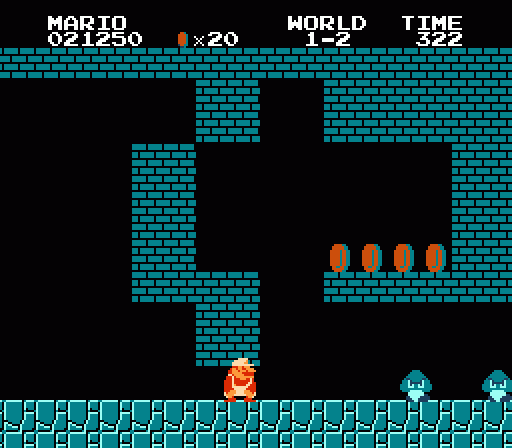
If you do kick and chase the Koopa shell, you may find yourself stymied by this low passage. Regular Mario can dash right through it, as he’s short enough to clear the low-hanging bricks. But Super Mario can’t. However, Super Mario can make his own passage by smashing the bricks to the left and climbing over the lower portion. This doesn’t do you much good if you’re chasing the shell, though; by the time you clear the bricks, it’ll be long gone, and those bonus points will evaporate.
But Mario has an advanced technique that he can use here. My guess is that it wasn’t a move built into the game deliberately but rather one that evolved from a combination of other play mechanics that the designers decided to capitalize on in non-essential ways. Mario can duck, and he experiences inertia when he moves. Duck while running, and he slides briefly. This happens to a smaller degree when he walks, but his walking inertia barely propels him forward. When running, though, he’ll slide forward a block or more. Time it right while chasing the shell and he can slide right below these bricks. And if you get stuck, the game automatically pushes Mario toward the nearest opening… though you can speed things along by smashing the bricks with a jump. Even though he doesn’t punch the bricks while squatting, Super Mario can shatter them all the same.
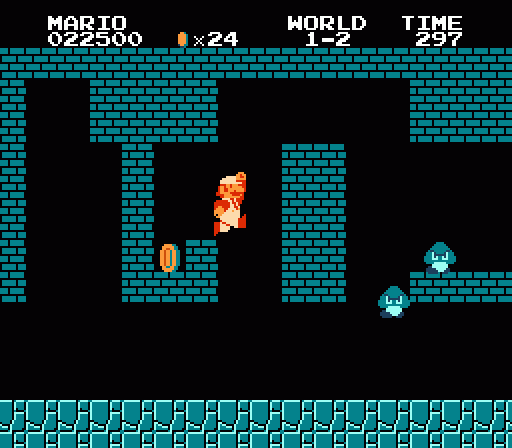
Further ahead, a pair of Gloombas drops from a platform to the ground. This serves as a subtle clue to jump up on the platform yourself and discover one of the game’s more interesting secrets, another element that seemingly evolved from the nature of the stage design.
Almost every block in World 1-2 is composed of brick. And Super Mario can shatter brick, as we’ve been reminded several times by this level’s little layout tricks. Eventually, you may begin to wonder: Can you break the bricks that define the level’s boundaries? And the answer, happily, is “yes.”
Around 1-2’s midpoint, you’ll encounter a few spots where Mario can shatter the ceiling of the stage. You can even leap onto the ceiling if you want, completely bypassing all the goodies (and dangers) below. But there’s a much better prize if you experiment a bit: Another 1UP mushroom that pops out of a certain block of the ceiling and slides along the upper edge of the stage. If you have sufficient mastery of Mario’s jump, you can create a hole for the mushroom to drop through; otherwise, you’ll need to chase it across the stage until it drops in a naturally occurring opening.
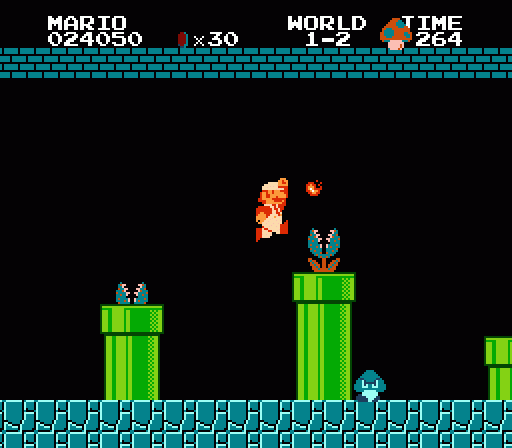
Whether or not you nab the 1UP mushroom, the game introduces a new danger soon after: Those familiar, friendly pipes suddenly take a turn for the nasty as deadly plants begin emerging from them. You can’t stomp a Piranha Plant, only fry it or wait for it to descend after a few seconds. They’re less insurmountable than you might think at first glance, though; if you stand on the pipe or on the block adjacent to it on either side, the plants won’t emerge.
In case you haven’t cottoned to the fact that you can drop down certain pipes, the plants allude to that: You can descend the first pipe to find a secret room full of coins. And unlike the World 1-1 coin room, this doesn’t serve as a shortcut; you actually ascend back to the main stage from the third pipe, a screen away from the entry pipe.
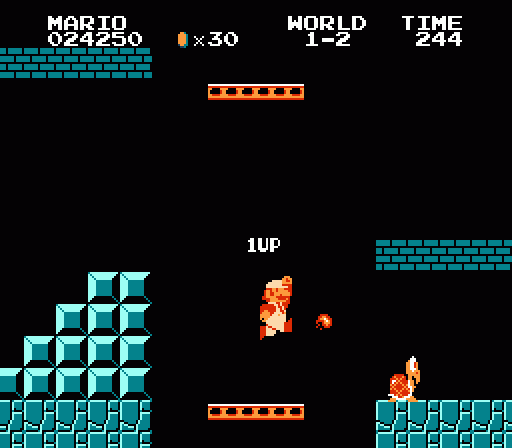
Beyond the pipes, World 1-2 introduces its second new element: Elevators. The first set of elevators descend constantly, and eventually they’ll drop off the bottom of the screen. Mario needs to be off the elevator before it reaches this point or else he drops off the screen with it, man down. The stage designers considerately provide a staircase leading up to the elevator so you’ll have plenty of time to leap to safe ground; you can even do a quick run-up and jump across to the opposite platform. Though you need to take care, as a Red Koopa Troopa (which is smart enough to turn around at the edge of a platform rather than drop down) patrols the lower path and is likely to smack into you if you jump carelessly.
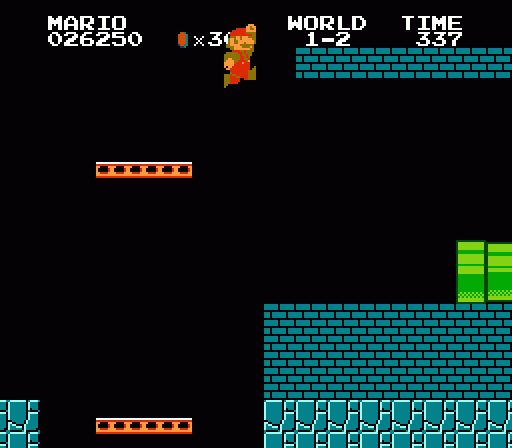
The second set of elevators rises, eventually ascending off the screen. This is less dangerous than the descending elevators, since Mario will simply drop to the next platform if he’s carried off the top edge. It’s a simple matter from here to jump over to the end pipe and take it up to the staircase and flagpole that mark the end of World 1-2.
But, you might also wonder, can Mario ride the elevator up and run along the ceiling? What would happen if you tried to skip past the end of the level? Would you be stuck forever?
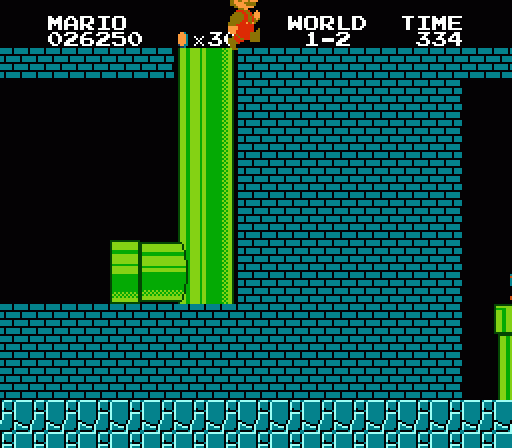
Yes, of course you can run along the ceiling. You should have realized that earlier when the game gave you the chance to break out of its boundaries! And of course the creators of Super Mario Bros. wouldn’t be so cruel as to give you an unwinnable situation (glitches don’t count) by stranding you here to let the clock run out. If you run past the pipe, you’ll find… a secret room.
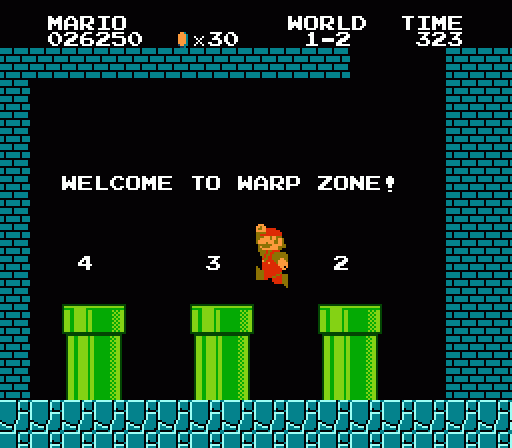
A room full of more pipes! Rather than taking you to the end of World 1-2, however, these pipes send you far beyond. They’re shortcuts to the worlds denoted above the different pipe: World 2-1, 3-1, or 4-1.
Obviously, you’re not meant (or expected) to find these right away. They’re tucked away in a hidden but not impossible spot for those with a fair amount of Super Mario experience to find by poking at the edges of the game and seeing what’s possible beyond “oh god oh god I hope this turtle doesn’t kill me aaaaaaghhh.” Because Super Mario Bros. lacks an obvious continue function or a save system, the Warp Zone gives you a way to jump ahead to where you were as you make progress further into the game — a time-saver for experienced players struggling with the latter stages. And one hidden in a simple fashion that curious players will eventually intuit on their own.
Can you break the boundaries of the world? Yes. And for trying to out-think the creators, you’re amply rewarded.
Great observations! But not only the piranha plants allude to the concept of going into pipes. The starting sequence of 1-2 is the first nudge in that direction although Mario ducking into the vertical pipe would have been even better. As far as I can remember the warp zone pipes had me trying to duck down in every pipe everywhere.
Yep, I mentioned that in yesterday’s post.
D’oh! Stupid night shifts. I didn’t read that one yet. Sorry!
A few other minor points: I think you can stomp those two gloombas at the same time at the beginning of the stage (provided you wait for them to pass the question blocks). It’s been a while since I’ve tried it, but I think it’s possible. You have to hit them precisely in the middle. Another point: you can actually get to the ceiling as early as the first koopa encounter. You’ll have to break enough of the bricks at the top, and leave yourself enough running space, but it’s possible.
Also, I did not know that the multi-coin bricks were timed. How could I not know that? This game is full of these little details in such a deceptive, simple sort of way. I love it.
Another spot-on write-up. Thanks, again.
I like Miyamoto’s quote about how the first level of their games is the last level they make (http://tinyurl.com/937r2vq). There’s no better way to ensure that the designers have a deep understanding of what their game actually IS before they try to teach it. But did they use that technique with this game? Or is that something the team figured out AFTER making this game? They HAD to, right? I mean, as Jeremy’s pointing out, world 1 couldn’t be a more perfect introduction…
There’s something to be said here about how Mario needs to tread lightly, but really I am just curious if you’ll be doin this final season of BB in (semi) real time.
Speaking of warp pipes can you cite any examples of game progressing warps before SMB? I can’t really think if any off the top of my head.
Atari arcade games did that a lot. Star Wars and Tempest let you pick a level at the title screen, and Crystal Castles (1983) had an in-game warp.
The unwillingness of the piranha plants to come out if you’re next to their pipe is something I discovered on my own, but in retrospect I’m surprised about that. It seems like the sort of thing I wouldn’t have known unless I’d read about it beforehand. I forget the moment I discovered it.
This is another example of good design. You quickly come to realize this trait of the plants because you’re almost certainly going to stand next to a pipe, waiting for the plant to emerge and retreat so you can dash over it. But it never comes out. Why? Because you’re standing next to it — the instant you back away, it pops out again. Simple, elegant, but clear.